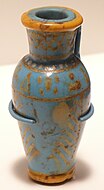Talk:Enamelled glass
A fact from Enamelled glass appeared on Wikipedia's Main Page in the Did you know column on 1 August 2020 (check views). The text of the entry was as follows:
|
| This article is rated B-class on Wikipedia's content assessment scale. It is of interest to the following WikiProjects: | ||||||||||||||||||
| ||||||||||||||||||
3959 views on dyk day (12 hrs)
Did you know nomination[edit]
- The following is an archived discussion of the DYK nomination of the article below. Please do not modify this page. Subsequent comments should be made on the appropriate discussion page (such as this nomination's talk page, the article's talk page or Wikipedia talk:Did you know), unless there is consensus to re-open the discussion at this page. No further edits should be made to this page.
The result was: promoted by Seven Pandas (talk) 14:26, 25 July 2020 (UTC)
( )

Thutmose III jar, c. 1425 BC
- ... that the earliest known vessel in enamelled glass comes from a pharoah's tomb of c. 1425 BC, after which there are no other pieces for some 1400 years? Gudenrath, W., Enameled Glass Vessels, 1425 BCE – 1800: The Decorating Process, Journal of Glass Studies, vol. 48, pp. 23–70, 2006, JSTOR. pp 28-30. Also same article Online at the Corning Museum of Glass (no page numbers): "The practice of creating enameled decoration on glass vessels began very soon after such vessels were initially made. A small turquoise-colored jug in The British Museum (Fig. 1.1) was probably found in the tomb of Thutmose III at Thebes, and it is thought to have contained sacred oils used in the burial ritual. The presence of the pharaoh’s cartouche on this vessel indicates an 18th-Dynasty date of about 1425 B.C.E..... Incredibly, the jug for Thutmose III appears to be the only surviving example of an enameled glass vessel that predates the Common Era...."
5x expanded by Johnbod (talk). Self-nominated at 01:12, 25 June 2020 (UTC).
 Great article with sufficient expansion, including expansion on text copied from another article. The article seems very euromediterranean-centric, and there's some flowery language (eg. "spectacular fashion"), but these do not feel like NPOV violations. I am refraining from passing right now because I feel the hook is too definitive in suggesting there was a 1400 year gap. The source is deliberately open to the possibility of later inventions, and these are objects that would be quite prone to not surviving long. The overall thrust is great, very hooky, but the wording needs slight tweaking. CMD (talk) 15:15, 13 July 2020 (UTC)
Great article with sufficient expansion, including expansion on text copied from another article. The article seems very euromediterranean-centric, and there's some flowery language (eg. "spectacular fashion"), but these do not feel like NPOV violations. I am refraining from passing right now because I feel the hook is too definitive in suggesting there was a 1400 year gap. The source is deliberately open to the possibility of later inventions, and these are objects that would be quite prone to not surviving long. The overall thrust is great, very hooky, but the wording needs slight tweaking. CMD (talk) 15:15, 13 July 2020 (UTC)
- Thanks, but I don't see the problem with the hook. Obviously we are talking about survivals, even as sherds, but if it had been in any regular use we would have these - the hook says "earliest known vessel". Glass, at least pieces of it (sherds), actually survive extremely well in the ground. The reason it is "very euromediterranean-centric" is that that is where irt was used, and important. The rather minor Chinese use of it, starting very late, is mentioned, and there is an image of a modern Japanese piece. Johnbod (talk) 15:40, 13 July 2020 (UTC)
- It was actually the Japanese image that made me look into the issue, as it was was a surprise to see after reading through the article content. I'm sure this is likely a reflection of the sources, but the article gives the feeling there's a bit more to say that's not there at the moment. On the hook, there's no indication that the Thutmose III jar was due to regular use either, so I don't feel that proves the definitive statement. However, I am happy to verify all the other requirements and ask for another opinion on just the hook if you'd like, as I can see the argument for the current wording. CMD (talk) 16:05, 13 July 2020 (UTC)
- Thanks, but I don't see the problem with the hook. Obviously we are talking about survivals, even as sherds, but if it had been in any regular use we would have these - the hook says "earliest known vessel". Glass, at least pieces of it (sherds), actually survive extremely well in the ground. The reason it is "very euromediterranean-centric" is that that is where irt was used, and important. The rather minor Chinese use of it, starting very late, is mentioned, and there is an image of a modern Japanese piece. Johnbod (talk) 15:40, 13 July 2020 (UTC)
Would this fish count as enamelled glass?[edit]
Glass-on-glass fish.[1] HLHJ (talk) 00:54, 29 August 2020 (UTC)
- Not according to this paper - see top of p. 14. Johnbod (talk) 02:41, 29 August 2020 (UTC)
- Yes, the decorative pattern is applied to the core first, and then the layer of clearish glass over that. I was just wondering if the initial spots were allowed to cool before the outer layer was added, so they would stay distinct, and later reheated to fuse. I guess you'd still probably dip it, not paint it, so it wouldn't be enamel anyway. HLHJ (talk) 04:19, 29 August 2020 (UTC)


